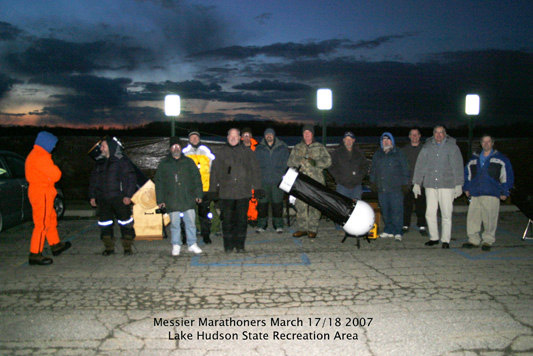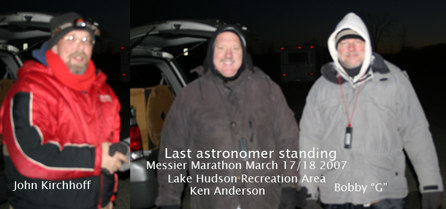


After several years of frustratingly fickle Michigan weather, this year was looking like it would yield at least a partial Messier Marathon. After one year of finding approximately 66 objects in a three-night stretch playing hide-and-seek with the clouds, and several years just plain clouded out, I really had the bug to get out and try it. A weather watch by several members concluded that the weather would be good enough for at least a partial try, with perhaps a partly cloudy start.
I wrestled with the desire to be successful and taking the 8” Infinity with its Sky Commander object locator, and the challenge of going it raw with more aperture and the 12.5” PortaBall. The group was also split between Peach Mountain and Lake Hudson. I finally loaded up the ‘Ball and headed for Lake Hudson, thinking that the lower horizons and larger aperture would give me more chance for success.
The word was that the activity would be at the beach at Lake Hudson, to provide the lowest horizons available. When I arrived, the clouds were still firmly in place, and the wind was pretty strong. There was a gentleman named Don from the Jackson Club who had already set up a fairly large Celestron SCT. He had also strung some painters’ tarps between several parking signs to act as a windbreak. This would end up making the night much more bearable. The temperature dropped below 30 degrees and the wind never died down below 10 or so mph, making for some pretty cold wind chills. As people started trickling in and setting up, the clouds began to dissipate. Doug Scobel showed up with the big dob, looking to do some more serious Herschel hunting, rather than Marathoning. He also brought out Nate Murphy’s 10” PortaBall, and Nate came out a short time later to set up and have a go. Doug Nelle showed up to make the “good Doug—evil Doug” team complete. More Jackson Club members came out, and near dark, John Kirchhoff arrived with his newest RV. John had all of the amenities to really make the night comfortable. He brought plenty of coffee and even prepared hot dogs later for energy in the middle of the night. A Huge Thanks John!!!
I used a plethora of resources to try to make as many objects as possible. With all of the tools, I thought that I would have a reasonable chance of viewing all 110 objects. Here is a list of all of the resources that I utilized in my quest:
The clouds parted just at sunset allowing for great viewing of the first items—M77 and M74. They turned out to be more visible than I had expected. I was sure glad that I settled on the PortaBall. Some of the Jackson guys came over to verify the starfields to make sure that they were looking in the right place. I know that I can’t remember the last time that I viewed these objects myself. The temperature stayed fairly constant and it got pretty quiet as we all went to work. Doug Scobel also borrowed my 35 mm Panoptic as part of his low-power eyepiece experiment. We did some quick testing with Saturn and some easy items. Nate was sharing some of his views with some folks who did not bring telescopes. Using the lists from the above-mentioned website, I went straight after the “Early Evening Group” and the “Big Dipper and Leo Area.” This was a fairly easy ride with the ‘Ball and pretty much went through viewing and logging. I came at this time to understand the true nature of the “marathon.” I took just enough time to view, verify, and log each item. No time to enjoy the view, just to catalog. I wonder what Charles Messier was thinking about as he was logging these items. During the Big Dipper Group, I logged NGC 5866, The Spindle Galaxy in Draco as M102. Both Astronomy Magazine and the web list recommended this.
At this time, I took a coffee break in John’s RV, and chatted with a few of the other folks who had also made it that far and were “caffeining up.” This is exactly what I thought a Messier Marathon would be like. Good views, good talks, and good coffee. I walked around and found out how far others had gotten. John was cruising along with his search and would soon be taking a break. During his break, he put in some hot dogs that would be ready for the next break. It was time to start on the Virgo Cluster.
Obviously this is one of the most difficult portions of the search. I used all of the tools available. I used the Watson Chart, page 3 of Volume 2, which shows a close-up of the Virgo Cluster. Then I supplemented that with Mark’s suggested tour of the area. Ultimately, I used the photos in the Astronomy Magazine pullout to verify the galaxies that I was unsure of. The stars shown in the photos around the galaxies in question helped me to make sure that I had the correct galaxy. This made everything go very smoothly, and I was finished in less than 2 hours. This allowed me to also knock off the “After Midnight Group” in short order. Many of the observers started leaving during this period of time. Nathan finally packed up around this time, and we helped the gentleman from the Jackson Club take down his tarps. I was then able to take an extended break in John’s RV.
The hot dogs that John cooked while he was taking his earlier break were a perfect snack. The coffee was hot and the RV was warm. I napped for an hour and was totally revitalized. I went out to see who was left. It was pretty much down to three of us. John was still struggling through the Virgo Cluster, so I gave him some moral support and went back to the ‘Ball. The other person left was Ken Anderson, also from Jackson. He had some questions and we did some co-verification. By now, it was around 5AM and time for the stretch run. “The Scorpius and Sagittarius Regions” were also difficult. Everything was pretty far south and this was the worst direction for horizon viewing. There were trees along with a small light dome from Morenci and Toledo. As I rolled down to the lower end of Sagittarius, it was a battle with the trees, and then, the Sun. When I finally gave up, I was at a count of 104 items. I missed out on M55, M75, M2, M72, M73, and M30. John had also missed M74 and was at 103 objects.
As we packed up to leave, the three of us took a moment to reflect on the nights’ activities. We had survived the weather and the fatigue to claim a fair victory in the world of the Messier Marathon. Admittedly, we did not see all 110 objects, but certainly not for lack of trying. We were diligent in our observation and verification of the objects that we did observe, and we did it on our own. We left with a great sense of satisfaction. It was 7:45 AM on Sunday morning, and I was headed off into the sunrise. I was very content with the whole experience, it was better that I had imagined. The weather cooperated for the whole night, a sky full of wonders to behold, and some really great observing partners. It was, however, not all fun and games. I did not take much time on any given object. I never trained my telescope on Jupiter, which was riding high in the sky at the end. The only exception was M104, which was spectacular. I enjoyed sharing it with several of the folks who were around at the time. I’m ready to try it again.
